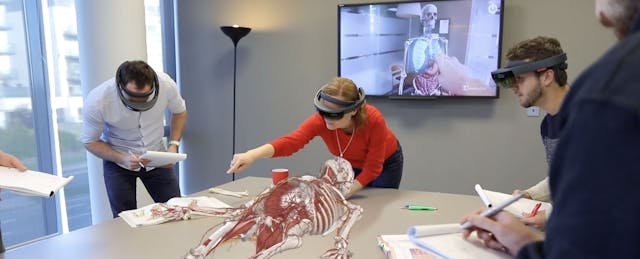As Pearson resumes its education technology investment activity, the publisher is also divesting other edtech assets at the same time.
On Dec. 16, Pearson announced the first two deals made by its recently formed venture fund, which invested $4.2 million in two companies: online bootcamp Springboard and Knowledge to Practice, a medical startup.
Now, the publisher confirmed that it has spun off its Immersive Learning team, selling its assets to a new company, GIGXR, based in Venice, Calif.
All nine staff formerly on that Pearson team will make the transition to the new company, which has a total headcount of 16. They will be led by CEO David King Lassman, who previously ran companies in the food, video and digital ad industries. But this latest gig (excuse the pun) also marks his return to the education industry. Back in the ’90s, he started a K-12 assessment software company, Doublestruck, which he sold in 1999.
Terms of the acquisition were not disclosed, but Lassman says he raised “just shy of $1 million to bring the assets out of Pearson.” He adds that he’s also raising more funding in a seed round that is expected to close in early 2020.
Pearson’s Immersive Learning team formed in 2015 through a partnership with Microsoft, which was looking to create educational apps for the HoloLens, the mixed-reality headset built by the technology giant. The pair announced their collaboration in 2016 at Educause, a major education technology conference, sharing that pilots were underway at several U.S. universities at the time.
The goal was—and remains—creating immersive educational experiences in “mixed reality,” which combines virtual and augmented reality technologies. In plainspeak, a user wears a headset that projects animations on real-world objects that he or she can interact with.
Conversations about spinning off this team began in early 2019, when Lassman says he was tapped to lead this charge.
“As part of Pearson’s restructuring, they want to return their focus to become the market leader in digital textbooks and courseware,” he tells EdSurge. “They recognized that for [the immersive learning team] to become a successful unit, it needed significant investment, and also the right kind of atmosphere and environment in which a company can thrive.”
As part of his effort to transform Pearson from a print-based to digital education company, CEO John Fallon has not shied from shedding brand name assets, including The Financial Times and its stake in The Economist. In education, it sold PowerSchool, widely used student information system, and its K-12 courseware business.
Pearson did not offer much detail about the decision to sell this unit.
“We remain interested in the potential of immersive technology, but believe the best way to deliver this effectively is by working with external specialist partners, such as GIGXR, going forward,” Pearson spokesperson Scott Overland said in an email.

Bringing Science Fiction to Life—and Learning
Under Pearson, the Immersive Learning team developed five apps, two of which have enjoyed some traction in the nursing education market. HoloPatient projects simulations of patients suffering from ailments that students learn to diagnose and treat. HoloHuman offers a holographic simulation of a human body, inviting users to probe muscles, vessels and other parts of the human anatomy.
Fifteen institutions, including Texas Tech University, the University of Queensland and the University of Leeds, are using these apps, according to Lassman.
Beyond the “wow” factor, these tools have the potential to make specialized training more cost effective. Many nursing and medical schools currently hire actors and makeup artists to mimic sick patients. The hope is to make digitally simulated patients and cadavers cheaper than real ones.
The other immersive learning apps developed under Pearson, which include tutoring for science subjects, have been put on hold “until we find a bigger footing in higher education,” says Lassman.
GIGXR sells annual licenses to its apps, and institutions currently pay between $18,000 to $100,000, depending on their size and implementation needs, he shares. That price does not include the hardware, which is not cheap. Schools and universities must separately purchase the HoloLens, which currently retails for $3,500.
For that reason, Lassman does not expect the company to focus on the K-12 market in the near term. And while the apps are currently only available on the HoloLens, the plan is to port them to other devices.
His hope is that the price will drop as more apps become available in the extended reality market.
Recalling his previous stint leading an education business, Lassman believes that this technology can be as “transformative as the computer and the internet,” adding that “when extended reality is accessible across the educational ecosystem, we’ll be able to do things that today seem like science fiction.”


